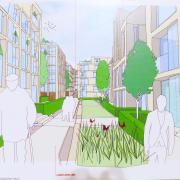
Landmark buildings at 113 Dundas Street and 34 Fettes Row look set to disappear under outline plans for a major new development here on land owned by the Royal Bank of Scotland.
The proposals were aired yesterday in the second of three public exhibitions featuring designs by development consultants GVA and Michael Laird Architects. All the display boards appear at the foot of this article.
The ‘ziggurat’ data centre at the corner of Fettes Row would be replaced by three south-facing residential blocks set back and screened by the trees which already line the street. They would be either five or six storeys high.
Similarly, another five residential blocks would rise from today’s car park, matching the curve of Royal Crescent. These too would be up to six storeys high, although we understand the two opposite Dundonald Street might be lower to help preserve what would remain of the view northwards.

A raised footpath and cycleway in front of these new buildings would connect the foot of Scotland Street to Dundas Street, with four access points to the street along the way.
Beyond these blocks would be smaller residential structures, with some being relatively low in order to prevent a sense of looming presence over the adjacent King George V Park. These are the most likely to be earmarked for the obligatory 25% affordable housing component of the development.
‘Rather than a continuation of urban blocks,’ reads one of the display boards, ‘we see the potential to create a parkland setting with stand alone building plots with spaces, routes and landscaping that flow between the buildings’.
Mixed use and ground-floor commercial
A new rectangular layout is envisaged for that part of the site bounded on three sides by the park, Eyre Place and Eyre Terrace. This could comprise mixed uses (residential, hotel, office and/or care home) with ground-floor commercial uses fronting Eyre Place.
Outline planning permission for such uses already exists, as reported here in Breaking news (8.4.14; 14/01177/PPP). One may therefore surmise that earlier plans for a tall structural statement or ‘end-point’ at the north-east angle have also been retained in developers’ thinking here.
A north–south footway starting beside this block would link Eyre Place to Royal Crescent.
Another hollow rectangle would occupy space at the lower end of Dundas Street and south of Eyre Place. This would again comprise ground-floor commercial and mixed uses.
In total, around 400 residential units are proposed, of which 100 would be affordable housing.
Access and public spaces
Vehicular access into and out of the development would be principally along Eyre Terrace, with all parking provided on-site and underground. Short points of approach, for emergency vehicles, would be available from Fettes Row and Royal Crescent.
Four transitional public spaces are envisaged: an ‘urban square’ off Dundas Street; a courtyard between the housing and the south-west corner of the park; an ‘entrance square’ opposite the bottom of Dundonald Street; and a ‘pocket park’ roughly at the foot of the path leading down from the north end of Scotland Street.

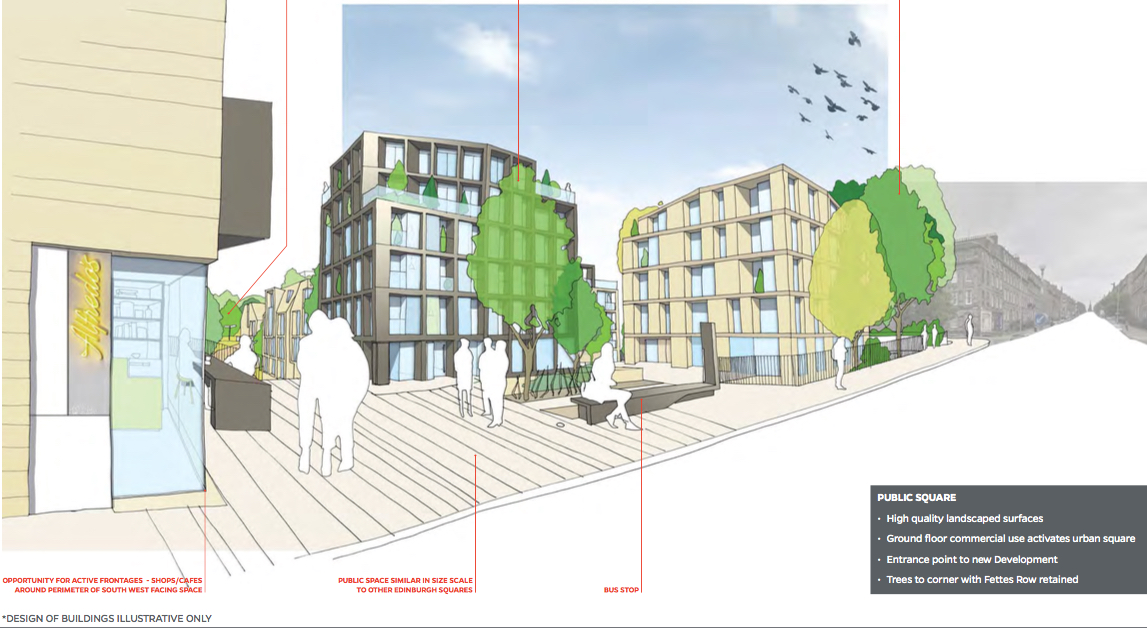
Reactions: the down side
The outline plans have sparked immediate alarm among some residents of Fettes Row and Royal Crescent who:
- fear damage to their property by pile-driving during construction, and potential drainage and landslip problems later
- dislike the prospect of being overlooked by anyone except faceless computer personnel and wildlife
- are concerned about overshadowing by new and higher residential blocks opposite.
GVA representatives say any such loss of light would be within tolerable and legally established margins, and that the buildings in question would be appropriately 'stepped back'.
The height of these residential blocks is a compromise, they say. The choice facing developers is between a continuous lower-level block or several higher blocks punctuated by green spaces in-between. (Several lower blocks appears not to be an option.)
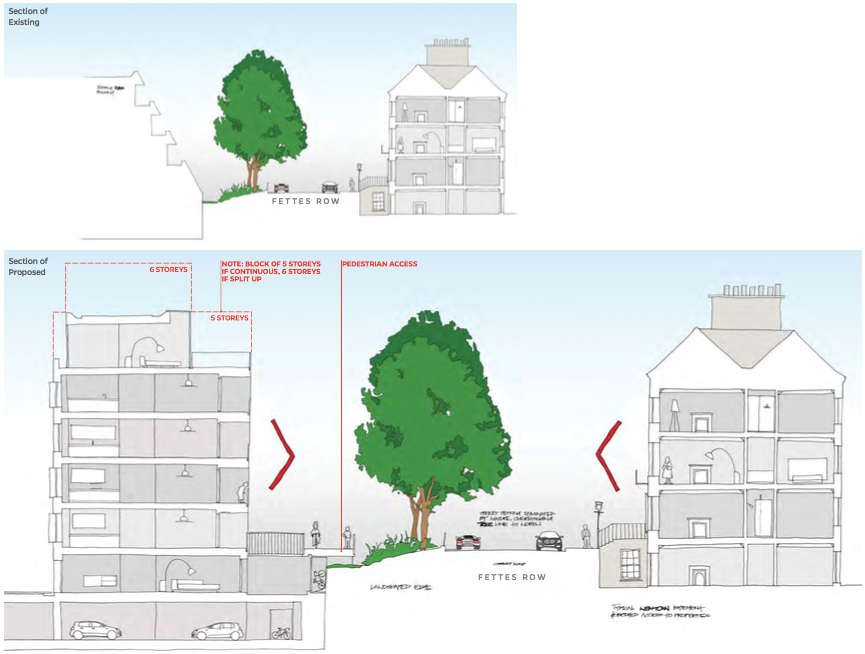
Spurtle spoke to one Jeremiah who expressed a mixture of disappointment and disgust at the ‘bland’ and ‘boring’ style of development visualised here. He said it was the Ubiquitous Vernacular of Nowhere, favoured by developers as a way of not frightening Planning departments. It has, he argues, nothing to say about its immediate setting or Edinburgh or Scotland in general.
Spurtle spoke to or eavesdropped on others who criticised some of the artistic impressions for conveying an overly optimistic sense of horizontal space and openness, particularly along Fettes Row (see below).
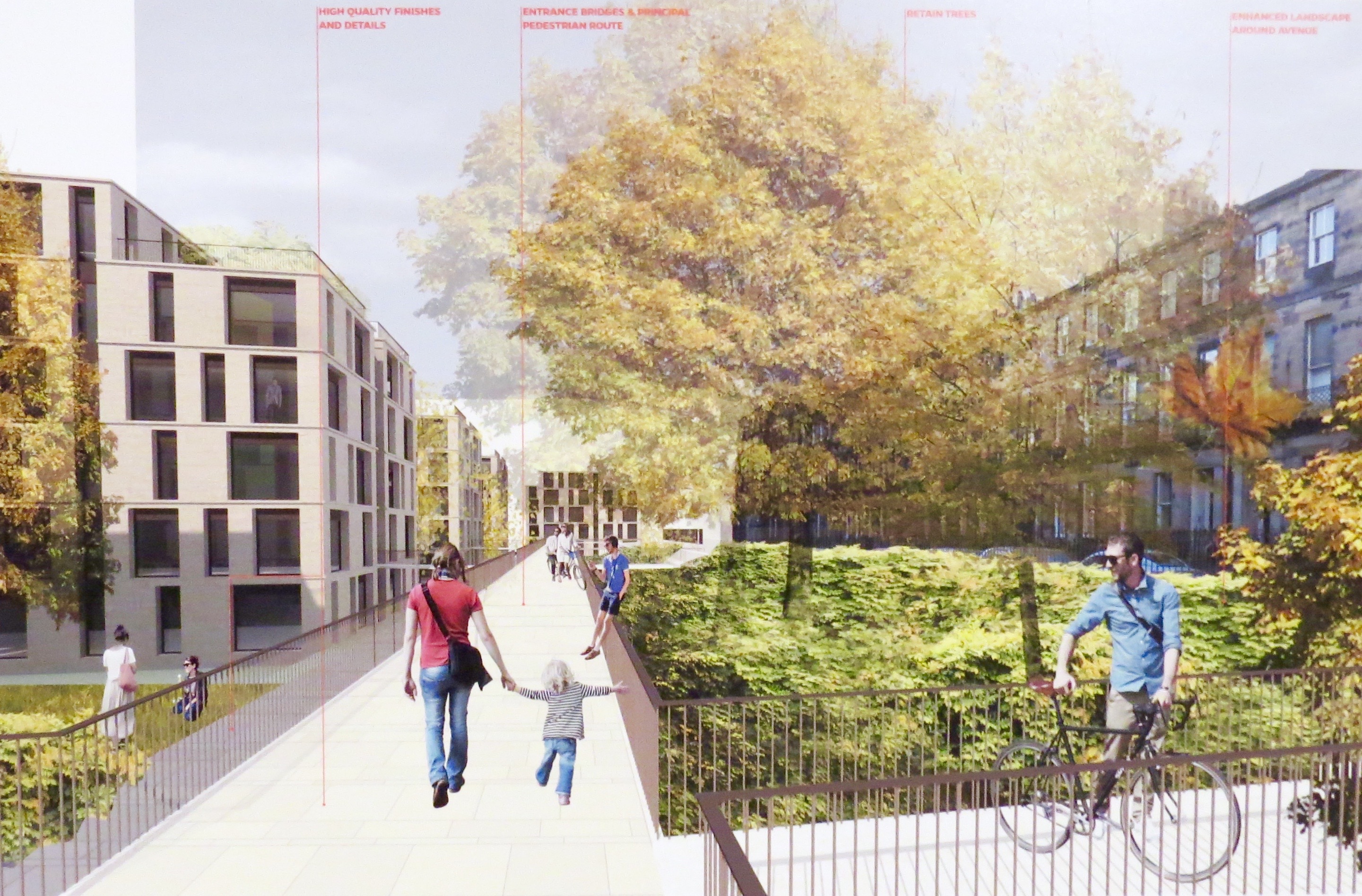
Doubts remain about the extent to which King George V Park may come to feel enclosed, shut away from its current long views south.
Despite the developers' protestations (see for example the Dundonald Street view pictured below), doubts were expressed about the loss of long views north, and the sense of dramatic sloping topography. (In fairness, many of these views may be available to elevated residents, but are not to pedestrians on Fettes Row and Royal Crescent.)

Grounds for optimism
Public reaction was by no means all bad. In fact, a lot of it was very good if less passionately expressed by those who felt they had something to gain rather than much to lose.
Spurtle heard approval for the consultation process so far, and appreciation that summaries on display were a fair representation of local sentiment. GVA certainly should have a handle on things, since its staff have been soliciting opinions in the area since January 2012 (Breaking news, 12.1.12).


We heard approval for the amount of green space in the proposal, and the permeability (in fact, often more visual than actual) between park and housing.

Those we spoke to during and after the event liked the proposal's aspirations for ‘parkland’ and ‘flow’, although were sceptical about the extent to which this could be realised in practice.
There was approval for the retention of trees along the development’s southern boundary.
We heard positive remarks about a ‘green corridor’ running east-west through the middle of the site, and the potential for views along it. There was also appreciation for the retention of south–north views across the site.
There were pockets of amusement at the repeated inclusion in mock-ups of one character who seemed to be wandering around in search of lost sheep.
What next?
Send in your comments (using the questionnaire form attached below, if you wish) by 4 December to: GVA James Barr, Quayside House, 127 Fountainbridge, Edinburgh EH3 9QG. When GVA have had a chance to collate and build upon feedback, a third consultation event will be held at a date yet to be confirmed. Any such remarks are not representations to the City of Edinburgh Council – such an opportunity will arise only when a formal planning application has been submitted.
-------------------------------------------
Got a view? Tell us at spurtle@hotmail.co.uk and @theSpurtle and Facebook
 Rachel Bell Hope the ziggurat isn't coming down, love that building. [Posted on Facebook early yesterday before plans were made public.]
Rachel Bell Hope the ziggurat isn't coming down, love that building. [Posted on Facebook early yesterday before plans were made public.]
 Elaine Goodall Loved working there and going to Clarke"s bar to get some liquid refreshment after work ..some great memories X
Elaine Goodall Loved working there and going to Clarke"s bar to get some liquid refreshment after work ..some great memories X
 Ella Taylor-Smith Not the time to ask RBS about their £4.5bn backing for nuclear bomb companies https://theferret.scot/rbs-under-fire-for-4-5bn-backing.../
Ella Taylor-Smith Not the time to ask RBS about their £4.5bn backing for nuclear bomb companies https://theferret.scot/rbs-under-fire-for-4-5bn-backing.../
 Bill Dunlop It's looking dead leafy on the plans (they always do) but I do feel they've underestimated the requirements for vehicular access (even for emergency vehicles) and I remain concerned for the future of the Eyre Terrace tenements.
Bill Dunlop It's looking dead leafy on the plans (they always do) but I do feel they've underestimated the requirements for vehicular access (even for emergency vehicles) and I remain concerned for the future of the Eyre Terrace tenements.
 Broughton Spurtle Which Eyre Place tenements, and why are you concerned?
Broughton Spurtle Which Eyre Place tenements, and why are you concerned?
 Bill Dunlop Eyre Terrace, not Place. there are really only two buildings, separated by a pend which could provide an additional access point, but I hae ma doots that developers will regard decorative (probably early C20) harling as sufficiently worthy of preservation. After the RBS complex, the most likely candidates for removal, I would have thought.
Bill Dunlop Eyre Terrace, not Place. there are really only two buildings, separated by a pend which could provide an additional access point, but I hae ma doots that developers will regard decorative (probably early C20) harling as sufficiently worthy of preservation. After the RBS complex, the most likely candidates for removal, I would have thought.
 Broughton Spurtle Understood. Decorative harling will probably drop off during demolition/pile-driving anyway. Interesting and quirky local detail—would be a shame to see it go.
Broughton Spurtle Understood. Decorative harling will probably drop off during demolition/pile-driving anyway. Interesting and quirky local detail—would be a shame to see it go.
 Alan Campbell I know which side of the street I'd rather live on ...
Alan Campbell I know which side of the street I'd rather live on ...
 Broughton Spurtle Not sure where you stand ... Would you rather live in a freezing cold, mouse-riddled 1821 flat with honking sewers and slow-draining sinks, looking out at 'hideous modern architecture' OR in an über-swish, 'soul-less', well-insulated development looking out on picturesquely decaying elevations/middle-class people living the 19th-century dream?
Broughton Spurtle Not sure where you stand ... Would you rather live in a freezing cold, mouse-riddled 1821 flat with honking sewers and slow-draining sinks, looking out at 'hideous modern architecture' OR in an über-swish, 'soul-less', well-insulated development looking out on picturesquely decaying elevations/middle-class people living the 19th-century dream?
 Alan Campbell Well, I live in a 1825 flat in Cumberland Street (south facing and very cosy) and have experienced only two mice in the last two decades. My sink drains fine and the sewers seem fragrant. The 21st century 'dream' of boxes that might be anywhere doesn't appeal I'm afraid - there ARE some interesting new buildings in the New Town but the artist's impression doesn't suggest these will fall into that category. .
Alan Campbell Well, I live in a 1825 flat in Cumberland Street (south facing and very cosy) and have experienced only two mice in the last two decades. My sink drains fine and the sewers seem fragrant. The 21st century 'dream' of boxes that might be anywhere doesn't appeal I'm afraid - there ARE some interesting new buildings in the New Town but the artist's impression doesn't suggest these will fall into that category. .
dOSs Retweeted Broughton Spurtle
@BrutalHouse Looks like one of my favourite Brutalist buildings is under attack from the Edinburgh Beige Council.
@theSpurtle @BrutalHouse You can argue it shouldn't have been put there in the first place, but it deserves protection now that it is.
@_d_O_S_s_ @BrutalHouse @theSpurtle Has a Glaswegian sibling, of a sort. http://photos.wikimapia.org/p/00/01/78/99/11_big.jpg …
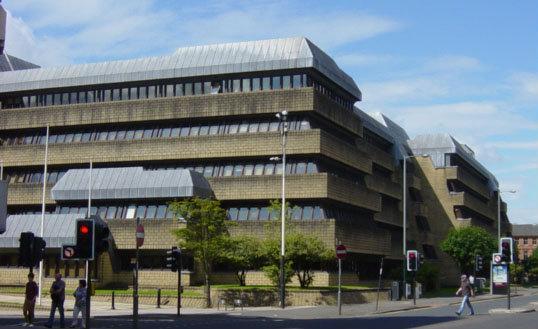
@LittleRedRhino @BrutalHouse @theSpurtle Similar indeed. Edinburgh has a moat around it though, very 'nuclear bunker'.
 The Marshmallow Lady @mallowlady_edi
The Marshmallow Lady @mallowlady_edi
@theSpurtle I hope those are REALLY early plans.. what a boring, uninspiring building.. bleugh...
 Ella Taylor-Smith Hard to read locals' reactions from the picture, but the guy on the right's looking pretty shifty.
Ella Taylor-Smith Hard to read locals' reactions from the picture, but the guy on the right's looking pretty shifty.
Maybe he's the architect.
@theSpurtle The ubiquitous vernacular of nowhere has become Edinburgh's signature look. I quite enjoy the paradox, but not the architecture.
Thanks @theSpurtle for alerting me to this. Looks positively awful. No relevance whatsoever to place and position.
 George Clerk The boards seemed to focus on showing spacious, leafy views of the Fettes Row side of the development, rather than artist impressions of the huge 'C' shaped four-storey block that's proposed along Eyre Place and most of the west side of the KGV park.
George Clerk The boards seemed to focus on showing spacious, leafy views of the Fettes Row side of the development, rather than artist impressions of the huge 'C' shaped four-storey block that's proposed along Eyre Place and most of the west side of the KGV park.
 Broughton Spurtle Agreed. Need more detail on this at next consultation exhibition.
Broughton Spurtle Agreed. Need more detail on this at next consultation exhibition.
 Nicole Roberts Took me ages to get my bearings!! The layout looks good, I like the fact you can walk through the buildings to get to the other side, but who knows what the actual flats will look like. That part is slightly terrifying.
Nicole Roberts Took me ages to get my bearings!! The layout looks good, I like the fact you can walk through the buildings to get to the other side, but who knows what the actual flats will look like. That part is slightly terrifying.
@theSpurtle @edinspotlight I note any loss of light will be within acceptable limits (or somesuch).Always what's said, & it's always *loss*.
 Unfunny Threadcloser Our govt were the main owner of RBS. They must have known about this. So they surely have to answer this one.
Unfunny Threadcloser Our govt were the main owner of RBS. They must have known about this. So they surely have to answer this one.
6 stories seems a bit high to me; also not happy with only 1 exit for 300 vehicles through Eyre Cres





